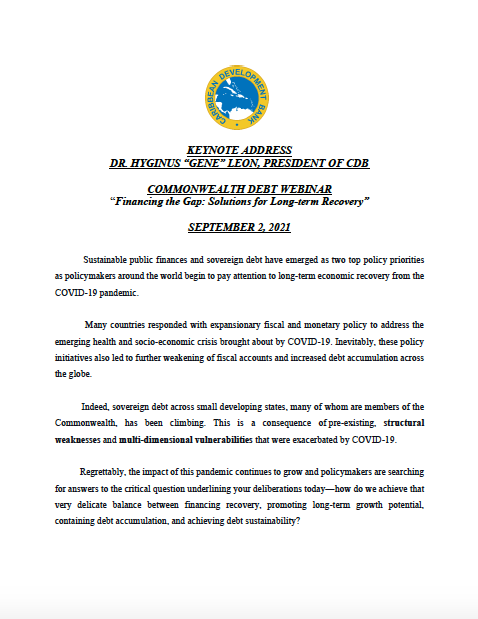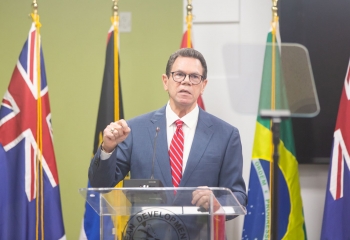Keynote Address: The Commonwealth Debt Webinar
Sustainable public finances and sovereign debt have emerged as two top policy priorities as policymakers around the world begin to pay attention to long-term economic recovery from the COVID-19 pandemic.
Many countries responded with expansionary fiscal and monetary policy to address the emerging health and socio-economic crisis brought about by COVID-19. Inevitably, these policy initiatives also led to further weakening of fiscal accounts and increased debt accumulation across the globe.
Indeed, sovereign debt across small developing states, many of whom are members of the Commonwealth, has been climbing. This is a consequence of pre-existing, structural weaknesses and multi-dimensional vulnerabilities that were exacerbated by COVID-19.
Regrettably, the impact of this pandemic continues to grow and policymakers are searching for answers to the critical question underlining your deliberations today—how do we achieve that very delicate balance between financing recovery, promoting long-term growth potential, containing debt accumulation, and achieving debt sustainability?
The path to a reasonable answer requires scrutiny of the key elements that affect countries' debt dynamics—in particular, sustainable economic growth, fiscal conditions, and the cost of financing. Moreover, the policy responses necessary for long-term transformative repositioning may be at odds with the policies that can jumpstart short-term recovery. So, it is vital that policies implemented for a short-term recovery effort be consonant with the policies required for a transformative long-term vision, at least to avoid the conflict of a short-term policy fix becoming a challenge for a long-term necessity.
Let me turn first to the issue of sustainable growth.
The development challenges ahead are formidable and unprecedented. The recovery of economies to pre-pandemic levels of activity will depend on the rate of vaccination and the evolution of the virus as far as the emergence of variants.
A combination of issues—unequal access to vaccines and health services, vaccine hesitancy, and the emergence of new variants of the virus—have heightened the uncertainty about the future course of the pandemic and the subsequent reopening and recovery of economies. As such, governments are inclined to continue supporting the strengthening of public health systems, maintaining relief mechanisms for the most vulnerable segments of society, and shoring up the production structure through liquidity measures. This, they continue to do despite deterioration of fiscal accounts, with increases in both primary deficits and gross public debt. Unfortunately, these rescue-based measures place countries on unsustainable paths and do not encourage structural change.
However, the pandemic affords countries an opportunity to anchor their long-term goals on sustainable, resilient development foundations. Starting from the recognition that economies are ecosystems, sustained long-term growth will require rebalancing existing structural weaknesses that impede growth and embracing innovation to build a resilient ecosystem. For small, open economies, this means the creation of structural conditions that lead to diversified export growth; financial systems that seek to manage risk; institutional development that promotes strong governance; a social culture that values welfare enhancement and a growth mindset; and adherence to a cross-cutting foundational principle of evidence-based decision creation.
In the Caribbean, many economies are highly export concentrated, depending almost exclusively on tourism for foreign exchange earnings. Building resilience and sustaining growth requires diversifying exports, which implies increasing competitiveness and creating innovative economies. The foundation for competitive and innovative economies are sound infrastructure and modern, facilitative institutional frameworks.
With considerations for climate change mitigation and resilience building, concepts of sustainable economic prosperity should be infused with ideas around green recovery and growth. These include the use of innovative approaches to sustainably develop blue economy models, transform agricultural practices to improve yields, and advance clean energy development, including renewable energy. In addition, sustainability and resilience require two key institutional constructs.
First, sound public finance management. While debt sustainability depends directly on fiscal performance, we cannot ignore the feedback loop from the structure of revenues and expenditures to growth. Therefore, it is incumbent upon the government to design national budgets that improve efficiency in all aspects of their operations. Expenditures should target high-priority activities, and strict budget controls exercised to contain widening financing gaps. This means rationalising tax expenditures, managing discretionary spending, and appropriately timing the reversal of measures taken to support recovery.
The maintenance of fiscal discipline can be entrenched through a fiscal anchor—for example, fiscal responsibility legislation to specifically target debt sustainability and build fiscal buffers. The work on those institutional systems can begin now and could be important signals to creditors that governments are serious about fiscal management even as they are confronted with extremely difficult conditions.
Second, effective debt management institutions and frameworks. These aim to efficiently manage credit risks and mobilise resources with a view to reducing the costs of government debt. A critical input for more favourable endogenous debt dynamics and debt sustainability is accessing financing at low, affordable rates. Countries will therefore have to target measures to reduce their risk premia over time, while leveraging the use of the most concessional funding available.
Importantly, apart from COVID-19, countries are faced with risks associated with climate change which create demand for higher levels of financing. This combined with an anticipated deterioration in the country’s debt dynamics could influence market perceptions of credit risk, leading to increased cost of borrowing. A manifestation of this could add another layer of complication to already challenging fiscal and debt conditions and create vicious cycles. A robust, and efficient debt management system can assist governments with containing the rising cost of debt in such situations.
Further, the occurrence of vulnerability events typically set back metrics for economic and social performance significantly, highlighting the need to integrate into a growth-investment-debt framework the concept of duration for re-attaining levels of pre-event economic and social metrics. This “vulnerability drag”, in contrast to the pre-event vulnerability probabilities, is probably the most significant factor distinguishing small, developing economies from larger, developed economies. Small size, export concentration, country-wide impact, and, in the case of natural hazards, the decimation of the efficiency of capital imply that significant resources are required over a long time to simply regain pre-event levels, let alone propel these economies toward higher potential growth.
Now, let’s consider financing the recovery
Financing needs going forward are enormous and will require multiple sources and appropriately designed instruments. The International Monetary Fund (IMF) identified pandemic recovery and development financing needs upwards of USD450 billion through 2025 for low-income countries alone! As such, support for the recovery would require significant resource mobilisation and innovative financing. The international community has taken steps to provide direct and indirect liquidity support to some of these states. The G-20 Debt Service Suspension Initiative (DSSI), and the broader Common Framework for Debt Treatments beyond DSSI (Common Framework)—which provide temporary debt service payment relief to free resources for COVID response—are relevant cases in point, notwithstanding their limitations.
Access to concessional resources is of particular importance to the most vulnerable states to limit long-term debt service drag and the impact on their already fragile fiscal and debt situations. As such, boosting concessional surge capacity at Multilateral Development Banks (MDBs) must be a priority for the international community. In that regard, the recent approval of IMF’s general allocation of SDR equivalent to USD650 billion will significantly boost global liquidity. The World Bank’s International Development Association replenishment has been advanced by a year to December 2021, making it possible to continue much-needed support to low-income countries on an earlier timetable. Other MDBs have also extended liquidity and budget support—in addition to front loading commitments and disbursements—and have committed additional resources to their members.
At the Caribbean Development Bank (CDB), we have provided our Borrowing Member Countries (BMCs) with liquidity support in the form of policy-based loans and debt financing support. We have also recently successfully completed negotiations for replenishment of the Tenth Cycle of the Special Development Fund (SDF-10), the Bank’s highly concessional financing to aid borrowing members with critical development priorities.
Beyond the impact of COVID-19, tourism-dependent middle-income countries such as those dominating the geographical landscape of the Caribbean are increasingly exposed to the damaging effects of climate change but are often ineligible for concessional emergency funding. As consideration is given in this forum to financing recovery from the COVID crisis, the ongoing threat of climate change must continue to be borne in mind. It is therefore important to appreciate the financing needs of these countries and to create opportunities for them to benefit from concessional windows of financing for extreme exogenous shock events. In the meantime, some countries in this grouping have experimented with state-contingent debt instruments, such as catastrophe bonds and contingent lines of credit, which they have been able to access in times of crisis. Many have also availed themselves of the range of parametric insurance policies offered by the Caribbean Catastrophe Risk Insurance Facility segregated portfolio company (CCRIF SPC). These should continue to be encouraged.
In this regard, CDB is advancing work on developing a Multi-dimensional Vulnerability Framework to better reflect the changing economic, social, environmental, and resilience conditions of small states in the Caribbean region. This work has the potential to assist in improving access to scarce concessional resources and accelerate progress towards development goals and targets.
In closing, the prevailing circumstances demand us to rescue and recover while reimagining a more resilient future state, but to do so without compromising debt sustainability. Maintaining debt sustainability will require that we focus on priority expenditures while optimising tax structures for revenue sufficiency, equity, economic efficiency, and simplicity. At the same time, financing needs must be met at the lowest cost, which translates to concessional terms from the optimal engagement of the multilateral development institutions, and/or more effective implementation of policies designed to reduce risk profiles. At CDB, we are fully engaged with our BMCs in support of their ongoing efforts to build the necessary resilience to recover sustainably. The international community has also signalled a commitment to support these endeavours. The rescue, recovery, and repositioning will require all parties to coalesce around an approach that is comprehensive and time-sensitive.



